Aston, Birmingham: Difference between revisions
No edit summary |
|||
| Line 18: | Line 18: | ||
==History== | ==History== | ||
[[File:Aston church Birmingham.jpg|thumb|250px|Church of SS Peter & Paul, Aston]] | [[File:Aston church Birmingham.jpg|thumb|250px|Church of SS Peter & Paul, Aston]] | ||
Aston was first mentioned in the [[Domesday Book]] in 1086 as "''Estone''", having a mill, a priest and therefore probably a church, woodland and ploughland. The Church of SS Peter & Paul was built in mediæval times to replace an earlier church. The body of the church was rebuilt by J. A. Chatwin during the period 1879 to 1890; the 15th century tower and spire, which was partly rebuilt in 1776, being the only survivors of the | Aston was first mentioned in the [[Domesday Book]] in 1086 as "''Estone''", having a mill, a priest and therefore probably a church, woodland and ploughland. The Church of SS Peter & Paul was built in mediæval times to replace an earlier church. The body of the church was rebuilt by J. A. Chatwin during the period 1879 to 1890; the 15th century tower and spire, which was partly rebuilt in 1776, being the only survivors of the mediæval building. | ||
The ancient parish of Aston (known as '''Aston juxta Birmingham''') is large and extends as far east as [[Water Orton]] and as far south as the county border with [[Worcestershire]] at Small Heath | The ancient parish of Aston (known as '''Aston juxta Birmingham''') is large and extends as far east as [[Water Orton]] and as far south as the county border with [[Worcestershire]] at Small Heath. It was partly included in the borough of Birmingham in 1838, and a further part, [[Saltley]] was added in 1891. | ||
Old buildings which became popular within Aston included the Aston Hippodrome and the Bartons Arms public house. Gospel Hall on Park Lane was opened in 1892 and demolished in the 1970s to be rebuilt at the top of Park Lane in 1979. The original hall had a seating capacity of 73. Another meeting place was the Ellen Knox Memorial Hall which was next door to the Midland Vinegar Brewery. The brewery was owned by the Midland Brewery Company was built around 1877.<ref>{{cite book|author=Douglas Hickman|title=Birmingham|pages=40|year=1970|publisher=Studio Vista Limited}}</ref> It was located on Upper Thomas Street. The brewery was a three storey brick building with rounded corners and semi-circular windows. The roof was slated. Other industry that was located in Aston include the Premier Motor Works which produced | Old buildings which became popular within Aston included the Aston Hippodrome and the Bartons Arms public house. Gospel Hall on Park Lane was opened in 1892 and demolished in the 1970s to be rebuilt at the top of Park Lane in 1979. The original hall had a seating capacity of 73. Another meeting place was the Ellen Knox Memorial Hall which was next door to the Midland Vinegar Brewery. The brewery was owned by the Midland Brewery Company was built around 1877.<ref>{{cite book|author=Douglas Hickman|title=Birmingham|pages=40|year=1970|publisher=Studio Vista Limited}}</ref> It was located on Upper Thomas Street. The brewery was a three-storey brick building with rounded corners and semi-circular windows. The roof was slated. Other industry that was located in Aston include the Premier Motor Works which produced cars during the early 20th century. The works were situated at the junction of Aston Road and Dartmouth Street. On Miller Street was a tramcar depot which had a storage capacity of 104 tramcars. It opened in 1904.<ref>[http://www.astonbrook-through-astonmanor.co.uk/aston_brook_through_aston_manor6d.htm Astonbrook through Astonmanor: Aston Development]</ref> | ||
Aston underwent large scale redevelopment following World War II. South Aston was designated a renewal area whilst a new town to the west of this.<ref>[http://www.bgfl.org/bgfl/custom/resources_ftp/client_ftp/teacher/history/jm_jones/jmj_redevelopment/jm_jones%20_pics/redevelop_1.jpg BGFL: Redevelopment and Renewal]</ref> This became "Newtown" and is a large estate consisting of sixteen tower blocks, five of which have since been demolished. The project was approved in 1968. Three 20 storey tower blocks on the complex contained 354 flats alone.<ref>[http://www.emporis.com/en/wm/cx/?id=101170 Emporis: Newtown, Birmingham]</ref> | Aston underwent large scale redevelopment following World War II. South Aston was designated a renewal area whilst a new town was established to the west of this.<ref>[http://www.bgfl.org/bgfl/custom/resources_ftp/client_ftp/teacher/history/jm_jones/jmj_redevelopment/jm_jones%20_pics/redevelop_1.jpg BGFL: Redevelopment and Renewal]</ref> This became "Newtown" and is a large estate consisting of sixteen tower blocks, five of which have since been demolished. The project was approved in 1968. Three 20-storey tower blocks on the complex contained 354 flats alone.<ref>[http://www.emporis.com/en/wm/cx/?id=101170 Emporis: Newtown, Birmingham]</ref> | ||
[[File:Villa Park - geograph.org.uk - 663895.jpg|thumb|250px|Villa Park, home of [[Aston Villa F.C.]]]] | [[File:Villa Park - geograph.org.uk - 663895.jpg|thumb|250px|Villa Park, home of [[Aston Villa F.C.]]]] | ||
Today, Aston is famous for [[Aston Villa F.C.]] and [[Aston University]] (the campus of which is not in Aston but actually located | Today, Aston is famous for [[Aston Villa F.C.]] and [[Aston University]] (the campus of which is not in Aston but actually located in Birmingham city centre). Aston University is one of three universities in Birmingham. Aston Villa have played at Villa Park since 1897, and it has traditionally been one of the largest football grounds in the country that has staged many notable matches at club and international level. The park has also hosted other sports and events including international level rugby league and rugby union. | ||
Much of Aston consists of terraced houses that were built around the end of the 19th century and the beginning of the 20th century. Some of these houses were demolished in the late 1960s to make way for the Aston Expressway, which links Birmingham city centre to the [[M6 motorway]]. In the late 1950s, Aston was the location of the famous 'Venus Baby' case of Cynthia Appleton (87 Fentham Road). | Much of Aston consists of terraced houses that were built around the end of the 19th century and the beginning of the 20th century. Some of these houses were demolished in the late 1960s to make way for the Aston Expressway, which links Birmingham city centre to the [[M6 motorway]]. In the late 1950s, Aston was the location of the famous 'Venus Baby' case of Cynthia Appleton (87 Fentham Road). | ||
Latest revision as of 17:13, 17 July 2020
| Aston | |
| Warwickshire | |
|---|---|
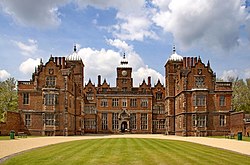 Aston Hall | |
| Location | |
| Grid reference: | SP072889 |
| Location: | 52°30’0"N, 1°52’48"W |
| Data | |
| Population: | 27,917 (2001) |
| Post town: | Birmingham |
| Postcode: | B6 |
| Dialling code: | 0121 |
| Local Government | |
| Parliamentary constituency: |
Birmingham Perry Barr |
Aston is a suburb of the city of Birmingham, lying in Warwickshire, immediately to the north-east of the city centre. To the east lies Erdington and to the west across the county border with Staffordshire lies the suburb of Handsworth.
History
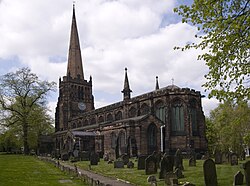
Aston was first mentioned in the Domesday Book in 1086 as "Estone", having a mill, a priest and therefore probably a church, woodland and ploughland. The Church of SS Peter & Paul was built in mediæval times to replace an earlier church. The body of the church was rebuilt by J. A. Chatwin during the period 1879 to 1890; the 15th century tower and spire, which was partly rebuilt in 1776, being the only survivors of the mediæval building.
The ancient parish of Aston (known as Aston juxta Birmingham) is large and extends as far east as Water Orton and as far south as the county border with Worcestershire at Small Heath. It was partly included in the borough of Birmingham in 1838, and a further part, Saltley was added in 1891. Old buildings which became popular within Aston included the Aston Hippodrome and the Bartons Arms public house. Gospel Hall on Park Lane was opened in 1892 and demolished in the 1970s to be rebuilt at the top of Park Lane in 1979. The original hall had a seating capacity of 73. Another meeting place was the Ellen Knox Memorial Hall which was next door to the Midland Vinegar Brewery. The brewery was owned by the Midland Brewery Company was built around 1877.[1] It was located on Upper Thomas Street. The brewery was a three-storey brick building with rounded corners and semi-circular windows. The roof was slated. Other industry that was located in Aston include the Premier Motor Works which produced cars during the early 20th century. The works were situated at the junction of Aston Road and Dartmouth Street. On Miller Street was a tramcar depot which had a storage capacity of 104 tramcars. It opened in 1904.[2]
Aston underwent large scale redevelopment following World War II. South Aston was designated a renewal area whilst a new town was established to the west of this.[3] This became "Newtown" and is a large estate consisting of sixteen tower blocks, five of which have since been demolished. The project was approved in 1968. Three 20-storey tower blocks on the complex contained 354 flats alone.[4]
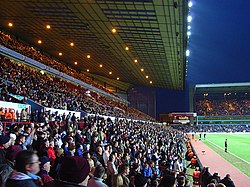
Today, Aston is famous for Aston Villa F.C. and Aston University (the campus of which is not in Aston but actually located in Birmingham city centre). Aston University is one of three universities in Birmingham. Aston Villa have played at Villa Park since 1897, and it has traditionally been one of the largest football grounds in the country that has staged many notable matches at club and international level. The park has also hosted other sports and events including international level rugby league and rugby union.
Much of Aston consists of terraced houses that were built around the end of the 19th century and the beginning of the 20th century. Some of these houses were demolished in the late 1960s to make way for the Aston Expressway, which links Birmingham city centre to the M6 motorway. In the late 1950s, Aston was the location of the famous 'Venus Baby' case of Cynthia Appleton (87 Fentham Road).
By the early 1980s, Aston was suffering from severe deprivation with many of the terraced houses being outdated for the requirements of the time. Many of them lacked bathrooms and indoor toilets, whilst the vast majority were suffering from decay as a result of a lack of maintenance. There was speculation that the homes would be demolished, but Birmingham City Council made money available to the homeowners for them to be brought up to modern standards.
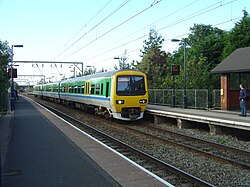
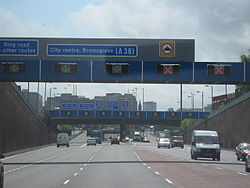
Education
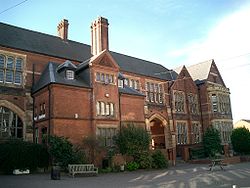
There are three secondary schools in Aston: Broadway School (Broadway also has a campus in Perry Barr), King Edward VI Aston and Aston Manor School. There are seven primary schools: Aston Tower Community Primary School, Birchfield Community School, Lozells Junior & Infant & Nursery School, Manor Park Primary School, Mansfield Green Community School, Prince Albert Junior and Infant School and Yew Tree Community School. Aston is currently served by Aston Library though the Library may be cut, Birmingham City Council blames lack of funding from the Central government.[5]
Aston Cross
Aston Cross was once the home of Ansells Brewery and HP Sauce. The six-acre Aston site was purchased by developer Chancerygate in 2007 at £800,000 per acre, but they subsequently sold it for half that price and it now houses a distribution warehouse for East End Foods. There is a campus of City College, Birmingham there. Aston Manor Brewery was started in Thimblemill Lane in 1982 by former employees of Ansell's after Ansell's Aston Brewery closed.
From 1956 to 1969, Aston Cross was the Midlands base of television broadcaster ATV which had its Alpha Studios on Aston Road North. The ATV office building later became the studios of radio stations BRMB and XTRA-AM. Although both stations moved to Birmingham's Broad Street in the early 1990s, the building is still called Radio House. Launching in February 1974, BRMB was the UK's fourth commercial radio station and, while in Aston, was the most listened to station in the West Midlands.
Notable residents
- All the original members of the heavy metal band Black Sabbath were born and raised in the Aston area.
- Victor Johnson, (1883–1951) was a track cycling racer, who in 1908, won a gold medal at the Olympics, became 'World Amateur Sprint Champion' and the 'British National Quarter-mile Champion'.
- John Benjamin Stone, a politician and prolific photographer, was born in Aston and took over his father's glass manufacturing business in the area upon his death.
- Albert Ketèlbey, composer, conductor and pianist, was born in Aston on August 9, 1875.
References
- ↑ Douglas Hickman (1970). Birmingham. Studio Vista Limited. pp. 40.
- ↑ Astonbrook through Astonmanor: Aston Development
- ↑ BGFL: Redevelopment and Renewal
- ↑ Emporis: Newtown, Birmingham
- ↑ Four Birmingham libraries facing closure because of budget cuts
- The City of Birmingham Baths Department 1851 - 1951, J. Moth, 1951